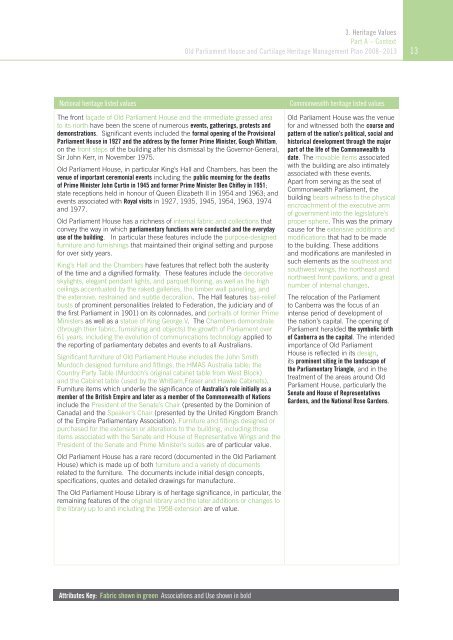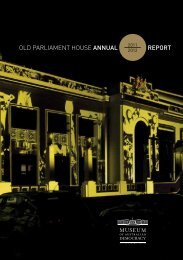OLD PARLIAMENT HOUSE AND CURTILAGE HERITAGE MANAGEMENT PLAN 2008–2013
Heritage Management Plan 2008-2013 - Museum of Australian ...
Heritage Management Plan 2008-2013 - Museum of Australian ...
- No tags were found...
You also want an ePaper? Increase the reach of your titles
YUMPU automatically turns print PDFs into web optimized ePapers that Google loves.
3. Heritage Values<br />
Part A – Context<br />
Old Parliament House and Curtilage Heritage Management Plan <strong>2008–2013</strong><br />
13<br />
National heritage listed values<br />
The front façade of Old Parliament House and the immediate grassed area<br />
to its north have been the scene of numerous events, gatherings, protests and<br />
demonstrations. Significant events included the formal opening of the Provisional<br />
Parliament House in 1927 and the address by the former Prime Minister, Gough Whitlam,<br />
on the front steps of the building after his dismissal by the Governor-General,<br />
Sir John Kerr, in November 1975.<br />
Old Parliament House, in particular King’s Hall and Chambers, has been the<br />
venue of important ceremonial events including the public mourning for the deaths<br />
of Prime Minister John Curtin in 1945 and former Prime Minister Ben Chifley in 1951;<br />
state receptions held in honour of Queen Elizabeth II in 1954 and 1963; and<br />
events associated with Royal visits in 1927, 1935, 1945, 1954, 1963, 1974<br />
and 1977.<br />
Old Parliament House has a richness of internal fabric and collections that<br />
convey the way in which parliamentary functions were conducted and the everyday<br />
use of the building. In particular these features include the purpose-designed<br />
furniture and furnishings that maintained their original setting and purpose<br />
for over sixty years.<br />
King’s Hall and the Chambers have features that reflect both the austerity<br />
of the time and a dignified formality. These features include the decorative<br />
skylights, elegant pendant lights, and parquet flooring, as well as the high<br />
ceilings accentuated by the raked galleries, the timber wall panelling, and<br />
the extensive, restrained and subtle decoration. The Hall features bas-relief<br />
busts of prominent personalities (related to Federation, the judiciary and of<br />
the first Parliament in 1901) on its colonnades, and portraits of former Prime<br />
Ministers as well as a statue of King George V. The Chambers demonstrate<br />
(through their fabric, furnishing and objects) the growth of Parliament over<br />
61 years, including the evolution of communications technology applied to<br />
the reporting of parliamentary debates and events to all Australians.<br />
Significant furniture of Old Parliament House includes the John Smith<br />
Murdoch designed furniture and fittings; the HMAS Australia table; the<br />
Country Party Table (Murdoch’s original cabinet table from West Block)<br />
and the Cabinet table (used by the Whitlam,Fraser and Hawke Cabinets).<br />
Furniture items which underlie the significance of Australia’s role initially as a<br />
member of the British Empire and later as a member of the Commonwealth of Nations<br />
include the President of the Senate’s Chair (presented by the Dominion of<br />
Canada) and the Speaker’s Chair (presented by the United Kingdom Branch<br />
of the Empire Parliamentary Association). Furniture and fittings designed or<br />
purchased for the extension or alterations to the building, including those<br />
items associated with the Senate and House of Representative Wings and the<br />
President of the Senate and Prime Minister’s suites are of particular value.<br />
Old Parliament House has a rare record (documented in the Old Parliament<br />
House) which is made up of both furniture and a variety of documents<br />
related to the furniture. The documents include initial design concepts,<br />
specifications, quotes and detailed drawings for manufacture.<br />
The Old Parliament House Library is of heritage significance, in particular, the<br />
remaining features of the original library and the later additions or changes to<br />
the library up to and including the 1958 extension are of value.<br />
Commonwealth heritage listed values<br />
Old Parliament House was the venue<br />
for and witnessed both the course and<br />
pattern of the nation’s political, social and<br />
historical development through the major<br />
part of the life of the Commonwealth to<br />
date. The movable items associated<br />
with the building are also intimately<br />
associated with these events.<br />
Apart from serving as the seat of<br />
Commonwealth Parliament, the<br />
building bears witness to the physical<br />
encroachment of the executive arm<br />
of government into the legislature’s<br />
proper sphere. This was the primary<br />
cause for the extensive additions and<br />
modifications that had to be made<br />
to the building. These additions<br />
and modifications are manifested in<br />
such elements as the southeast and<br />
southwest wings, the northeast and<br />
northwest front pavilions, and a great<br />
number of internal changes.<br />
The relocation of the Parliament<br />
to Canberra was the focus of an<br />
intense period of development of<br />
the nation’s capital. The opening of<br />
Parliament heralded the symbolic birth<br />
of Canberra as the capital. The intended<br />
importance of Old Parliament<br />
House is reflected in its design,<br />
its prominent siting in the landscape of<br />
the Parliamentary Triangle, and in the<br />
treatment of the areas around Old<br />
Parliament House, particularly the<br />
Senate and House of Representatives<br />
Gardens, and the National Rose Gardens.<br />
Attributes Key: Fabric shown in green Associations and Use shown in bold




